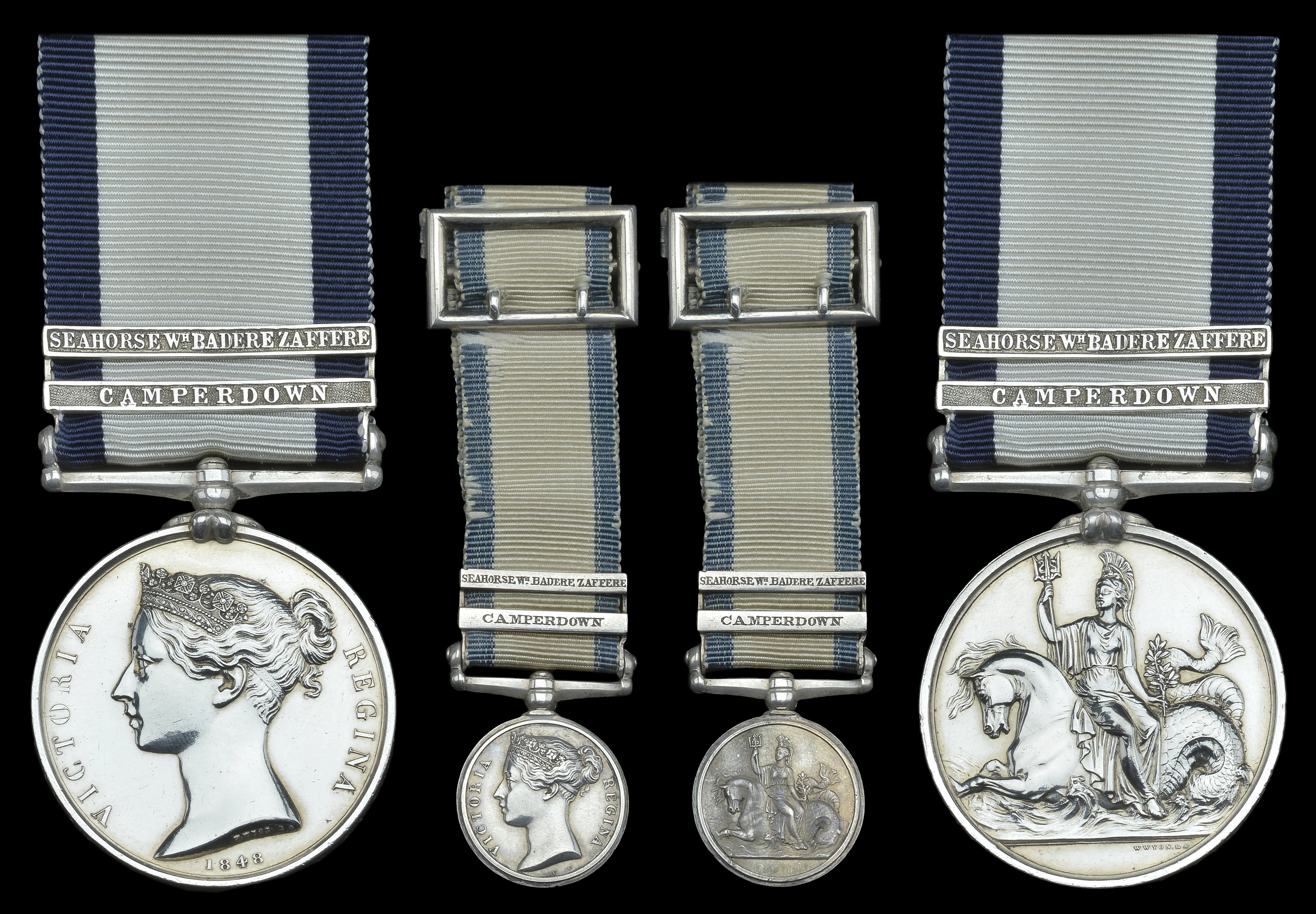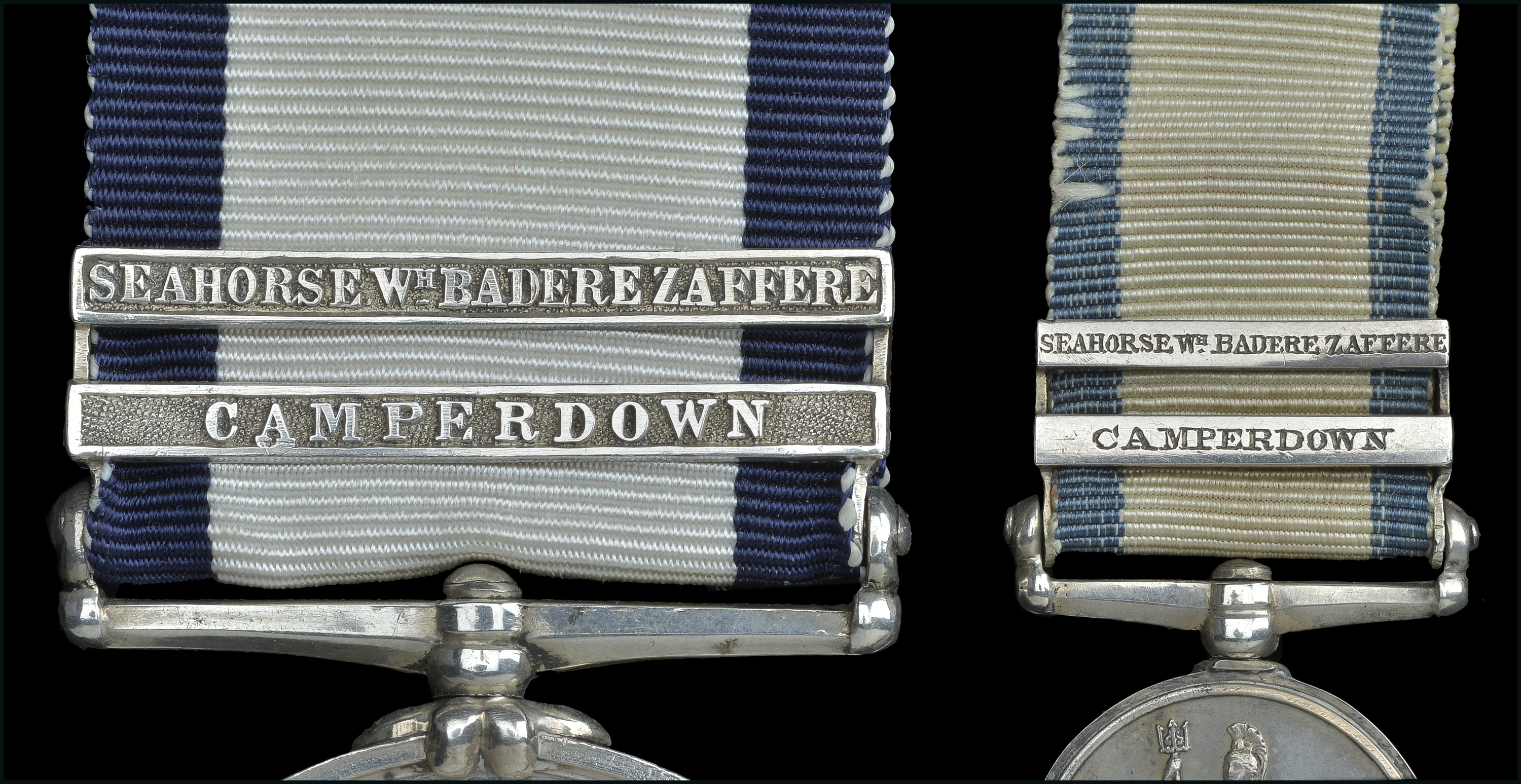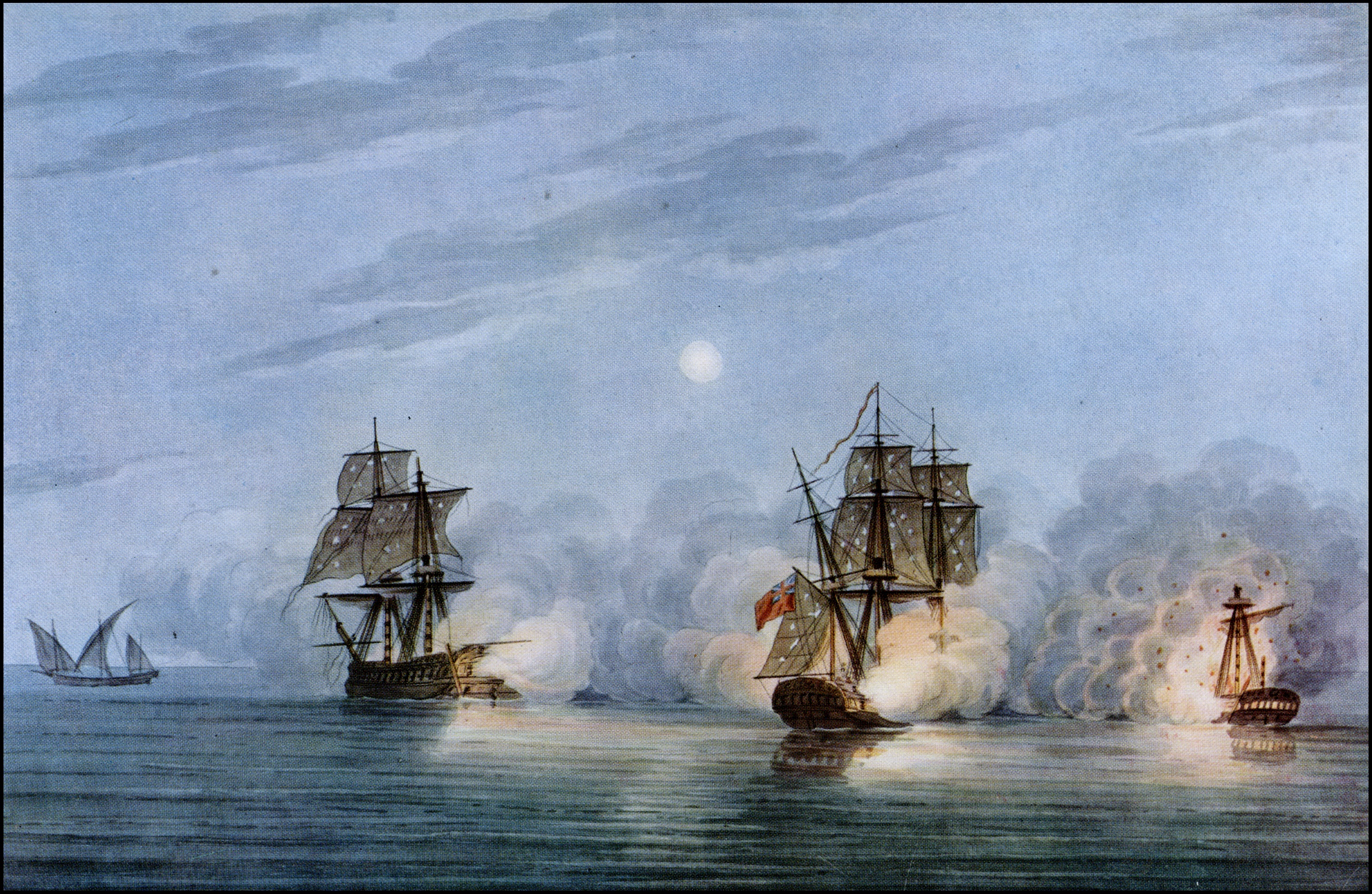The outstanding N.G.S. medal awarded to Admiral Thomas Bennett, R.N., who was wounded as a 12 year-old midshipman at the battle of Camperdown, and was second Lieutenant of the Seahorse in Captain John Stewart’s extraordinary and brilliant ‘Gold Medal’ night action with a Turkish squadron in July 1808 Naval General Service 1793-1840, 2 clasps, Camperdown, Seahorse Wh Badere Zaffere (Thomas Bennett, Lieut.) together with contemporary miniature medal with two engraved clasps on original ribbon fitted with silver ribbon buckle, good very fine (2) £18,000-£22,000 --- Provenance: Sotheby, June 1971 (to Fergus Gowans Collection); Glendining’s, March 1989; John Goddard Collection, Dix Noonan Webb, November 2015. Camperdown [298 issued] - including 3 officers and 20 men of the Monarch. Seahorse Wh Badere Zaffere [32 issued] - including 11 officers of which the following six are known: Thomas Bennett, Lieutenant (third senior officer aboard the Seahorse and senior surviving claimant); Hon. George P. Campbell, Midshipman; Lord John Hay, Midshipman; Viscount A. G. Kenmore, Midshipman (Honeyman Collection, Huntington Library, U.S.A.); William Oastler, Surgeon; Edwin L. Rich, Midshipman (Royal Naval Museum). A surprisingly rare clasp despite the number awarded. Thomas Bennett was born on 22 February 1785, at Hereford, a nephew of Francis Bennett, Esq., Purser of the Nassau 64, who perished in that ship when wrecked on the coast of Holland, 14 October 1799, and of Commander William Bennett, R.N., who died in 1819. He entered the Navy in March 1797 as a Volunteer, on board the Monarch 74, Captain John Elphinstone, flagship afterwards of Vice-Admiral Richard Onslow, under whom he fought and was wounded, while only twelve years of age, in the battle of Camperdown, 11 October following. On leaving the Monarch, in which ship he had previously witnessed the mutiny at Spithead, he successively joined the Nassau 64, Captains William Hargood and George Tripp, guard-ship at the Nore, and, in the early part of 1798, the Amphion 32, Captain Richard Henry Alex. Bennett, employed on the North Sea, African, and West India stations. Among other achievements he assisted, while cruizing off the island of Jamaica in company with the Alarm 32, in effecting the capture, 25 November 1799, of the Asturiana, Spanish letter-of-marque, mounting 28 guns, with a complement of 180 men; and for his zeal and activity on various occasions, but more especially in the boat-chase of a privateer off Port Royal, was ultimately, in 1801, transferred by the Commander-in-Chief, Lord Hugh Seymour, to his flagship, the Sans Pareil 80. The premature death, however, of the gallant Admiral depriving him of the immediate promotion he had been promised, Mr. Bennett did not obtain any advancement in his profession until January 1802, when he appears to have been appointed Acting-Lieutenant, for a short time, of the Tartar 36, and Vanguard 74, both commanded by Captain James Walker. He returned home in the course of the same year on board the Cerberus 32, Captain James Macnamara; and on being reappointed as Admiralty Midshipman, at the commencement of hostilities, to the Amphion, then commanded by Captain Thomas Masterman Hardy, conveyed Lord Nelson to the Mediterranean, where he was promoted by his Lordship, who had previously made him his Signal Officer, into the Camelion 18, Captain Thomas Staines, 25 July, 1803 – an act which was officially confirmed on 9 December following. During the next two years Bennett was warmly engaged, nearly the whole time as First-Lieutenant, in destroying the enemy’s coasting-trade between Toulon and Genoa. On one occasion, on 29 August 1803, whilst attacking five vessels under the batteries at Rimasol, his clothes and hat were shot through in an extraordinary manner, and every person in his own boat, except himself, two men, and a boy, was either killed or wounded. Seahorse with Badere Zaffer, Gold Medal action In May 1805, after assisting at the capture, within sight of the British fleet, of Le Renard schooner, of 12 guns, he exchanged into the Seahorse, of 42 guns and 281 men, commanded at first by Captains Hon. Courtenay Boyle and Robert Corbett, and from April, 1806, until June, 1811, by Captain John Stewart, in whose distinguished services during that period he proved an active participator. On the failure of Sir Arthur Paget’s pacific mission to restore peace between Great Britain and Turkey, Captain Stewart was despatched, in August 1807, to examine the ports in the Cyclades, to report as to their capacity, and to promote and facilitate trade with Malta. Cruizing in the Archipelago on the evening of 5 July 1808, the Seahorse fell in with two Turkish frigates, the Badere Zaffer, 52 guns, and the Alis-Fezan of 26 guns. The crew of the Badere Zaffer alone was nearly double that of the Seahorse, and her armament was heavier, but Captain Stewart engaged both ships, and after an action of about half an hour, the smaller Turkish frigate, much damaged, made sail away. Her consort fought in the most determined manner, and made several unsuccessful attempts to board the Seahorse, who poured broadside after broadside into her opponent with most destructive effect. For more than three hours the contest raged, from nine p.m. till past midnight, when the ships separated, the Turk with all her topmasts shot away, and her fire silenced. At dawn, the Seahorse bore down to renew the engagement, and the Turkish captain, though ready to fight again, was compelled by his crew to surrender, his ship being so shattered that she was with difficulty kept afloat. What occurred after the Badere Zaffer had struck her colours is best told in the words of an officer present: ‘The little Arab who commanded the Turkish ship, on being brought aboard and asked for his sword, had no idea of surrendering it; indeed he had, immediately after his colours were struck, dressed himself entirely in white, meant perhaps as a flag of truce. Having obtained permission to return to his ship, and being in the confusion of the moment unguarded, he got one of the fighting lanterns, which were still alight, and had reached the magazine passage then not secured, and over ankle deep in gunpowder, when just as he was in the act of taking the candle from the lantern the schoolmaster, who had come aboard the prize from curiosity, and happened to be providentially on the lower deck, immediately on seeing the danger knocked down the Arab, dowsed his glim, and saved us from the inevitable destruction of one, if not both, frigates. He was removed on board the Seahorse, and as he spoke Italian fluently, Captain Stewart rebuked him severely in that language for his breach of the laws of honour and war, to which he listened with unmoved patience. When the speaker ceased, the little tiger bent forward his head, and pointing to his neck, said, “Take it, it is yours, don’t hesitate, for had the fortune of war been mine I would have had your head off two hours ago. I only did my duty in attempting to blow up my ship, and I curse my own stupidity for not succeeding.” His officers declared that during the action he had put 17 of his own men to death with his own hand in attempting to keep them at their quarters.’ The British loss was five men killed and ten wounded; the loss of the enemy, one hundred and seventy killed and about two hundred wounded, many mortally, showing the difference in the handling and gunnery of the two ships. Captain Stewart took his shattered prize into Malta, and being unsuitable for the British Navy, she was sold to some merchants. In addition to the Naval Gold Medal, Captain Stewart received a £100 sword from the Lloyd’s Patriotic Fund for this service. The First-Lieutenant, George Dow...












